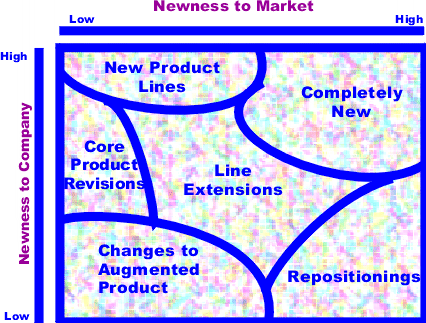New product development
|
|
New Product Development is a business and engineering term which describes the complete process of bringing a new product to market. There are two parallel aspects to this process : one involves product engineering ; the other marketing analysis. Marketers see new product development as the first stage in Product Life Cycle Management.
Types of new products
There are several types of new products. Some are new to the market, some are new to the firm, and some are new to both. Some are minor modifications of existing products while some are completely innovative. These are displayed in the following diagram.
The process
There are several stages in the new product development process:
- 1 Idea Generation
- ideas for new products obtained from customers, R&D department, competitors, focus groups, employees, or trade shows
- formal idea generating techniques include attribute listing, forced relationships, brainstorming, morphological analysis, problem analysis and early, rapid prototyping
- 2 Idea Screening
- eliminate unsound concepts
- must ask three questions:
- will the target market benefit from the product
- is it technically feasible to manufacture the product
- will the product be profitable
- 3 Concept Development and Testing
- develop the marketing and engineering details
- who is the target market
- what benefits will the product provide
- how will consumers react to the product
- how will the product be produced
- what will it cost to produce it
- test the concept by asking a sample of prospective customers what they think of the idea
- develop the marketing and engineering details
- 4 Business Analysis
- estimate likely selling price
- estimate sales volume
- estimate profitability and breakeven point
- 5 Beta Testing and Market Testing
- produce a physical prototype or mock-up
- test the product in typical usage situations
- make adjustments where necessary
- produce an initial run of the product and sell it in a test market area to determine customer acceptance
- 6 Technical Implementation
- New program initiation
- Resource estimation
- Requirement publication
- Engineering operations planning
- Department scheduling
- Supplier collaboration
- Resource plan publication
- Program review and monitoring
- Contingencies - what-if planning
- 7 Commercialization
- launch the product
- produce and place advertisements and other promotions
- fill the distribution pipeline with product
- critical path analysis is useful at this stage
These steps may be iterated as needed. Some steps may be eliminated. To reduce the time the process takes, many companies are completing several steps at the same time (referred to as concurrent engineering). Most industry leaders see new product development as a proactive process where resources are allocated to identify market changes and seize upon new product opportunities before they occur (in contrast to a reactive strategy in which nothing is done until problems occur). Many industry leaders see new product development as an ongoing process (referred to as continuous development) in which a new product development team is always looking for opportunities.
Because this process typically requires both engineering and marketing expertice, cross-functional teams are a common way of organizing a development project. The team is responsible for all aspects of the project, from initial idea generation to final commercialization, and they usually report to senior management (often to a vice president). In those industries where products are technically complex, development research is expensive, and product life cycles are short, strategic alliances amoung several organizations helps to spread the costs, provide access to a wider skills set, and speeds the process.
People respond to new products in different ways. The adoption of a new technology can be analyzed using Diffusion of innovations theory.
Protecting new products
When developing a new product many legal questions arise, including: How do I protect the innovation from imitators?; Can the innovation be legally protected?; For how long?; How much will this cost?. The answers are complicated by the fact that several legal concepts may apply to any given innovation, product, process, or creative work. These include patents, trademarks, service marks, tradenames, copyrights, and trade secrets. It is necessary to know which are applicable and when each is appropriate. This varies somewhat from jurisdiction to jurisdiction. The advice of a lawyer that specializes in these matters is essential.
Generally, copyrights are fairly easy to obtain but are applicable only in certain instances. Patents on the other hand, tend to involve complex claims and approval processes, tend to be expensive to obtain, and even more expensive to defend and preserve.
See also
- Product management
- Product life cycle management
- brand management
- marketing
- Engineering
- product
- Document management
References
- Crawford, M. (1994) New Product Management, 4th Edition, Irwin Co, Burr Ridge Ill., 1994.
- Crawford, M. (1977) Marketing research and the new product failure rate, Journal of Marketing, vol 41, April 1977, pp 51-61.
- Drucker, P. (1985) The discipline of innovation, Harvard Business Review, vol 63, May-June 1985, pp 67-72.
- Ironmonger, D. (1972) New commodities and consumer behaviour, University of Cambridge Department of Applied Economics, Monograph 20, Cambridge University Press, Aberdeen, 1972. This source is an economics book rather than a management or marketing one. It introduces the concept of new product development to the economics of consumer behaviour.
- Lynn, G., Marone, J. and Paulson, A. (1996) Marketing and discontinuous innovation, California Management Review, spring 1996, pp. 8-37.
- Urban, G. and Hauser, J. (1993) Decision and marketing of new products, 2nd Edition, Prentice Hall, Englewood Cliffs, 1993.
- Urban, G., Hauser, J. and Dholakia, N. (1987) Essentials of new product management, Prentice Hall, Englewood Cliffs, 1987. ISBN 0-13-286584-X
- The idea of categorizing new products according to their "newness to market" and their "newness to the company" originated in: New Product Management for the 1980s, Booz, Allen, and Hamilton, New York, 1982.de:Produktentwicklung

